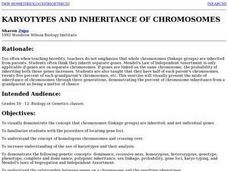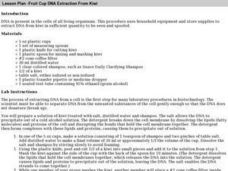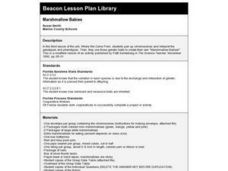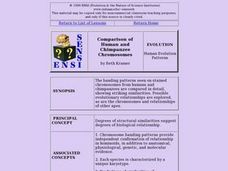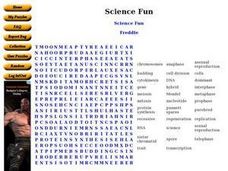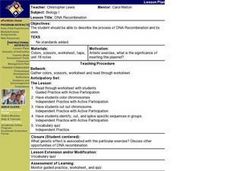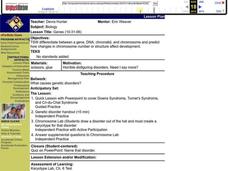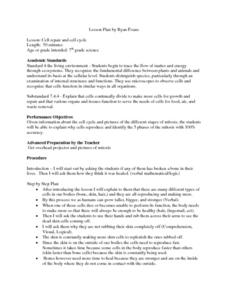Curated OER
Chromosomes and Genetic Mapping
Learners create models of chromosomes using clay, coins, beads, or marbles. They complete a worksheet regarding their crossover frequencies they created with their chromosomes and gene models. They read an essay on sex chromosomes and...
Curated OER
Karyotypes and Inheritance of Chromosomes
Students explore the mode of inheritance of chromosomes. Given a scenario, students use the Human Genome sheet to determine inherited chromosomes. They illustrate the difference between genotype and phenotype. Students develop a model...
Curated OER
Fruit Cup DNA Extraction From Kiwi
Learners extract DNA from kiwi using household equipment and supplies.
Curated OER
Marshmallow Babies
Eighth graders interpret the genotypes and phenotypes, then pair up chromosomes.
Curated OER
Pair 'Em Up!
Third graders verify the validity of Punnett squares. They simulate a real-world situation by drawing chromosomes from a paper bag and track the data.
Curated OER
The Chromosome Connection Comparison of Human and Ape Chromosomes
Students participate in a chromosome comparison "adventure", in which the banding patterns are compared on the chromosomes of humans and apes.
Curated OER
DNA AND PROTEIN SYNTHESIS IN THE CELL
Learners explore the structure of DNA and the process of DNA replication, describe the process of protein synthesis, recognize the importance of proteins in the human body, and look at how mutations affect protein synthesis.
Curated OER
Genetics: Genes and DNA
Students study DeoxyriboNucleic Acid or commonly known as DNA and discover importance of DNA strand, chromosomes, and genes.
Curated OER
Nature And Nurture
Learners develop an understanding of the role both nature and nurture play in determining an individual's traits. Using a website, students answer questions about nature and nurture in order to solve the riddle, What do you call a smart...
Curated OER
Comparison of Human and Chimpanzee Chromosomes
Pupils actively engage in the careful analysis of chromosome banding patterns and identify examples of inversion in homologous chromosomes.
Curated OER
Chromosomes, DNA, and Genes-Roadmap To Understanding The Foundation Of Genetics
Students investigate DNA by doing a hands on activity. In this activity lesson students participate in a lab that allows to explore DNA and chromosomes.
Curated OER
Online Research for a Genetic Disorder
In this genetics worksheet, students access a given website, chose a genetic disorder, and complete the 10 short answer questions about the disorder.
Curated OER
Reproduction and Development
In this development worksheet, students compare the characteristics of mitosis and meiosis. Students review the male and female reproductive organs and their functions. This worksheet has 4 graphic organizer, 6 short answer, and 16 fill...
Curated OER
Replication of DNA
For this replication of DNA worksheet, students match the correct definition of DNA replication to the terms given. Students also complete given statements with the correct term in the space provided.
Curated OER
DNA Replication
In this DNA replication worksheet, students review the steps that take place for DNA replication. This worksheet has 9 fill in the blank questions.
Curated OER
Word Search on Mitosis
For this biology worksheet, students identify and locate various vocabulary terms related to the process of mitosis. There are 19 biology terms located in the word search.
Curated OER
Cell Word Search
In this biology learning exercise, students identify and locate various vocabulary terms related to cells. There are 12 biology terms located in the word search.
Curated OER
Science Fun
For this biology worksheet, students identify and locate various vocabulary terms related to the cells of the body. There are 32 biology terms located in the word search.
Curated OER
DNA Recombination
Students describe the process of DNA Recombination and its uses. They are asked what genetic effect is associated with the exercise? Students discuss other opportunities of DNA recombination. They are given a worksheet, and students...
Curated OER
Genes
Students discuss the difference between a gene, DNA, chromatid, and chromosome. They predict how changes in chromosome number or structure affect development. Students discuss what causes genetic disorders. They view a PowerPoint that...
Curated OER
What Do Genes Look Like?
Seventh graders describe the basic structure of the DNA molecule. They identify what an inherited trait is and how it can be determined by one or more genes. Finally, 7th graders identify that plant and animal cells contain several...
Curated OER
Cell Repair and Cell Cycle
Seventh graders explore the cell cycle. They view pictures of different stages of mitosis and explain why cells reproduce. They identify the five phases of mitosis: interphase, prophase, metaphase, anaphase, and telophase.
Curated OER
Extracting DNA
Students explore DNA, genes, chromosomes and the chemicals that make up DNA. They research Internet resources to develop their knowledge of DNA. They conduct an experiment to separate DNA from peas and create a poster that they can use...
Curated OER
Teaching Biotechnology by Analogies and Models
Students examine analogies and create models to help visualize the concept and technique of basic biotechnology. Common scenarios are used to explain the complex procedures of genetic engineering.



